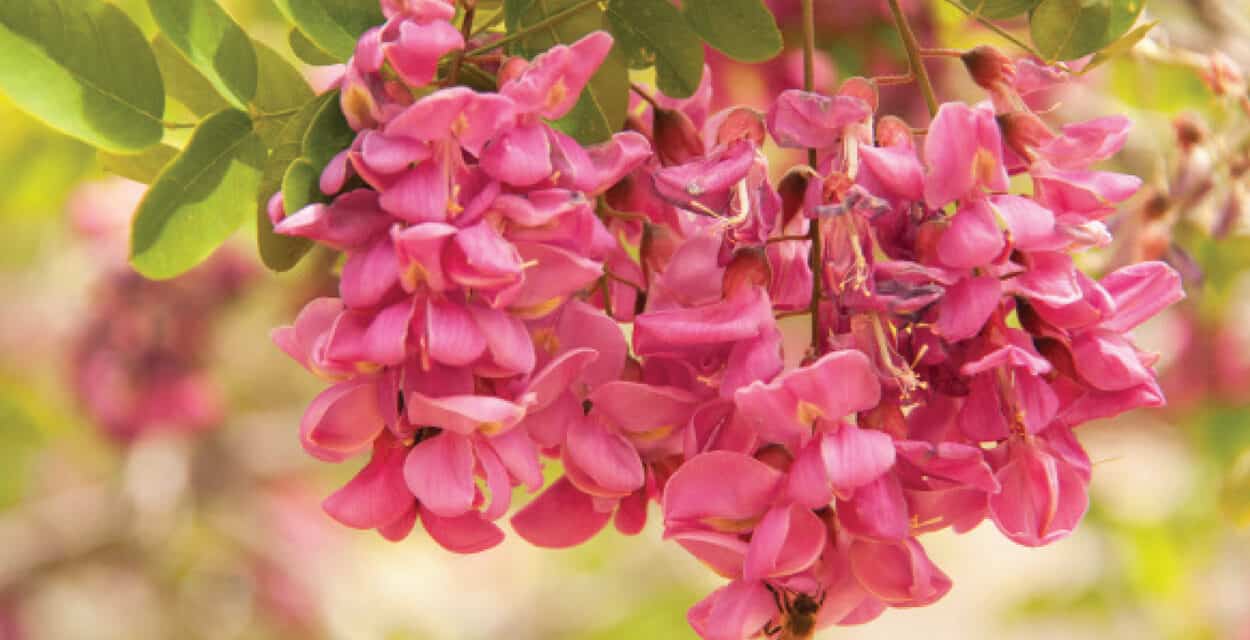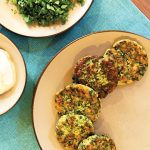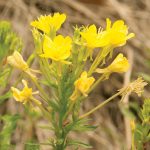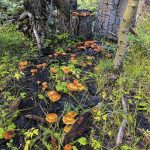A tree, not a bug
Words and Photos by Ellen Zachos

The next time you’re driving down the street in spring and see a tree dripping with long clusters of gorgeous pink flowers, stop and smell the New Mexico locust. These flowers only last for about two weeks, depending on the weather. (Hot weather makes the blooms pass more quickly than cool weather.) You’ll find them in late spring to early summer, depending on where you forage. It’s a native tree with beautiful blooms that can be used to make fritters and syrups or be added raw to salads. Robinia neomexicana is an easy tree to spot and identify, especially in bloom. Pull over!
The New Mexico locust is an understory tree native to the southwestern United States. In the wild, they grow to be about ten to fifteen feet tall and are often multistemmed, with pale pink flowers. Cultivars of New Mexico locust have been bred as single-stemmed trees with bright pink blooms. They may grow to be twenty to twenty-five feet tall and are often planted as street trees. The tree has a suckering growth habit, which means it spreads by underground rhizomes. It’s not unusual to find thick clonal clumps growing in nature.
The leaves of the New Mexico locust are a pretty blue-green, and composed of multiple leaflets. Cultivars bred for landscaping may not have thorns, but locust trees in nature are heavily armed. Most bear pairs of sharp thorns at the base of each leaf, especially on their younger branches, so be careful when you reach in to pick a cluster of flowers. Also, this is an important pollinator plant and a favorite for all sorts of flying insects, so be sure not to disturb them as you forage.
The stems of each flower cluster are tender enough to snap off with your fingers, or you can use a pair of pruners. Give your flowers a shake (to get rid of any hitchhikers) and refrigerate them in a plastic bag if you don’t plan to use them right away. They’ll keep in the refrigerator for a few days.
You’ll find lots of recipes online for locust flower fritters. They’re a tasty treat and fun to make with kids, but you won’t really get to appreciate the flavor or texture of the locust flowers this way. Honestly, what wouldn’t taste good dipped in batter, deep fried, and sprinkled with powdered sugar?
Raw flowers, on the other hand, make a great addition to salads and desserts. They have excellent substance and texture, and make a sweet, satisfying pop when you bite down on them. Sprinkle individual flowers on top of all kinds of salads—green, pasta, tuna, chicken—or onto ice cream, cupcakes, or panna cotta. The flavor is floral, naturally sweet (but not overwhelmingly so), and a little fruity.
Making a syrup with locust flowers is a great way to capture the flavor and color of the blooms, and it can be used in different ways. My favorite way to use it is as a base for sorbet. The addition of lemon juice turns the syrup from purple to magenta. It’s as beautiful as it is delicious.

Locust Flower Sorbet
Ingredients
- 2 cups locust blossoms
- 2 cups sugar
- 2 cups water
- Juice of 1 lemon
Instructions
- Remove the locust flowers from their stems and put them in a bowl. Add 1/4 cup sugar, and mash the flowers into the sugar with a pestle until the flowers have formed a paste. Two cups of flowers and 1/4 cup sugar should reduce to about 1/2 cup of paste.
- Combine water and remaining 1 3/4 cups sugar in a saucepan, and bring to a boil, whisking to dissolve the sugar. Add the flower paste, stir, and reduce heat to a simmer. Let the syrup simmer for 10 minutes, then remove from heat, cover, and let cool for at least an hour, or overnight.
- Strain off the solids, pressing down on them to extract as much liquid as possible. Then strain the syrup one more time to catch any little bits and pieces.
- Add lemon juice and prepare to be amazed! The dark purple syrup turns magenta as it combines with the acidic lemon.
- Refrigerate syrup for at least an hour, then process in your ice-cream maker. If you have a few leftover blossoms, sprinkle them on top of the sorbet when you serve it—a feast for the eyes and the stomach.

Ellen Zachos
Ellen Zachos lives in Santa Fe and is the author of eight books, including the recently released The Forager's Pantry. She is the co-host of the Plantrama podcast (plantrama.com), and writes about wild foods at backyardforager.com. Zachos offers several online foraging courses at backyard-forager.thinkific.com.













